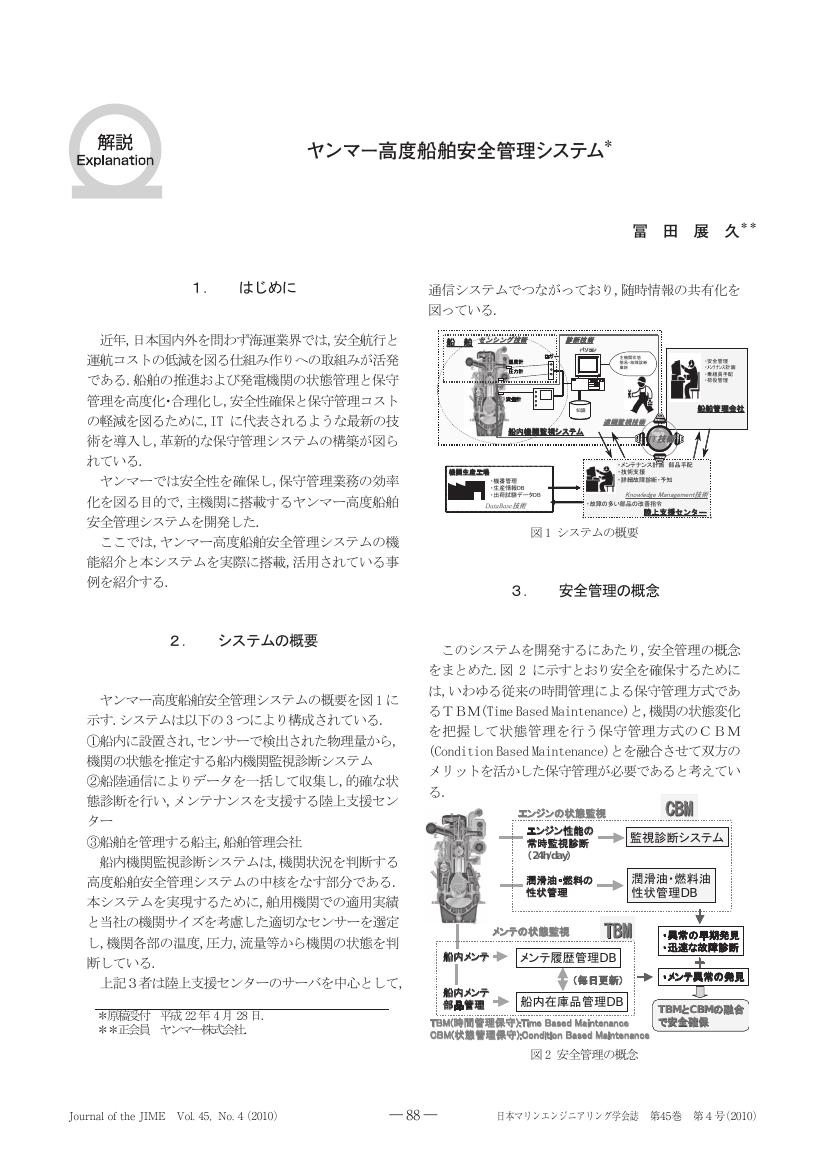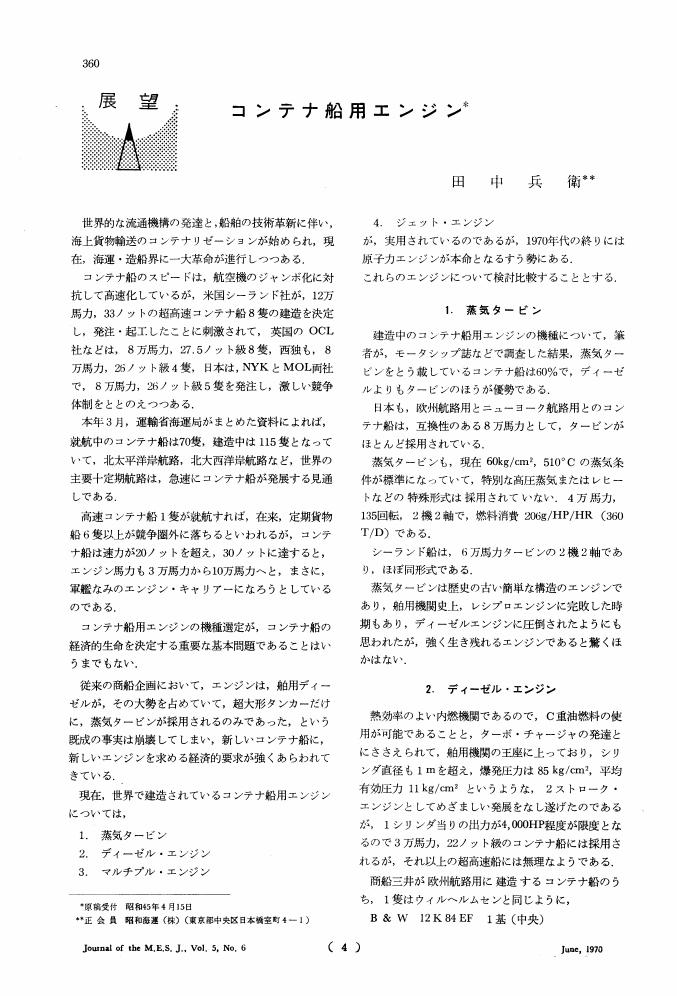1 0 0 0 OA 海事教育機関における人材育成の現状と課題 - 船員不足と教官不足
- 著者
- 引間 俊雄
- 出版者
- 公益社団法人 日本マリンエンジニアリング学会
- 雑誌
- マリンエンジニアリング (ISSN:13461427)
- 巻号頁・発行日
- vol.52, no.6, pp.750-755, 2017-11-01 (Released:2018-03-07)
- 参考文献数
- 13
1 0 0 0 OA 深海底リアルタイム観測ネットワークの構築
- 著者
- 川口 勝義
- 出版者
- 公益社団法人 日本マリンエンジニアリング学会
- 雑誌
- マリンエンジニアリング (ISSN:13461427)
- 巻号頁・発行日
- vol.44, no.1, pp.58-63, 2009 (Released:2012-02-29)
- 参考文献数
- 5
- 被引用文献数
- 1
1 0 0 0 OA 原子力船の検査について
- 著者
- 今井 清
- 出版者
- 公益社団法人 日本マリンエンジニアリング学会
- 雑誌
- 日本舶用機関学会誌 (ISSN:03883051)
- 巻号頁・発行日
- vol.7, no.12, pp.883-888, 1972 (Released:2010-05-31)
- 参考文献数
- 7
1 0 0 0 OA 最近の商船の特殊な保有運航について (仕組船)
- 著者
- 真砂 宏
- 出版者
- 公益社団法人 日本マリンエンジニアリング学会
- 雑誌
- 日本舶用機関学会誌 (ISSN:03883051)
- 巻号頁・発行日
- vol.14, no.3, pp.262-267, 1979-03-01 (Released:2010-05-31)
1 0 0 0 OA 川崎重工業の舶用再熱蒸気タービン推進プラントについて
- 著者
- 半田 昌平 吉川 洋平
- 出版者
- 公益社団法人 日本マリンエンジニアリング学会
- 雑誌
- マリンエンジニアリング (ISSN:13461427)
- 巻号頁・発行日
- vol.51, no.6, pp.755-760, 2016-11-01 (Released:2018-01-01)
- 参考文献数
- 5
1 0 0 0 OA 我が国における舶用発電タービンの変遷
- 著者
- 永島 俊三郎
- 出版者
- 公益社団法人 日本マリンエンジニアリング学会
- 雑誌
- 日本舶用機関学会誌 (ISSN:03883051)
- 巻号頁・発行日
- vol.18, no.6, pp.465-470, 1983-06-01 (Released:2010-05-31)
- 参考文献数
- 9
Marine use turbine-generators in Japan have remarkably developed concerning their reliability, overall turbine efficiency, operation easiness, governing performance and heat recovery system, etc.This paper explains the technological progress of marine use turbine-generator in Japan since 1911, when Mitsubishi Nagasaki Shipbuilding Co. (present Mitsubishi Heavy Industries Co.) completed 1st unit of Parsons' type steam turbine for 200 kW DC generator.Summary of historical topics on marine turbo-generator is listed in the table.In 1982, Ishikawajima-Harima Heavy Industries Co., and Mitsubishi Heavy Industries Co. completed the mixed pressure type turbine-generator for motorship, and they are efficiently operated on board.About seventy years have passed since 1911, and we can keep in mind of various efforts which led to modern turbine-generators.
1 0 0 0 OA Weis-Fogh (ヴァイスフォー) メカニズムを応用した船舶の推進
- 著者
- 蔦原 道久 木村 雄吉 盧 基徳
- 出版者
- 公益社団法人 日本マリンエンジニアリング学会
- 雑誌
- 日本舶用機関学会誌 (ISSN:03883051)
- 巻号頁・発行日
- vol.23, no.8, pp.474-479, 1988-08-01 (Released:2010-05-31)
- 参考文献数
- 14
- 被引用文献数
- 2 2
A two-dimensional model of the Weis-Fogh mechanism, which is a mechanism of hovering flight of small insects, is applied to ship propulsion. A model of the propulsion mechanism consisting of one or two wings in a square channel is proposed. The thrust and the drag on the wing, which are defined, respectively, the force in the direction of progress of the ship and that of movement of the wing, are measured. The propulsive efficiency is calculated and is high when the moving speed of the wing is small compared with the advancing speed of the ship. A model ship equipped with this propulsion mechanism is made and working tests performed. The applicability of this propulsion mechanism to actual ships is expected to be good.
1 0 0 0 OA ディーゼル重量車における排出ガス規制と対応技術の推移
- 著者
- 鈴木 央一
- 出版者
- 公益社団法人 日本マリンエンジニアリング学会
- 雑誌
- マリンエンジニアリング (ISSN:13461427)
- 巻号頁・発行日
- vol.49, no.6, pp.776-781, 2014-11-01 (Released:2015-12-16)
- 参考文献数
- 2
- 被引用文献数
- 1 2
1 0 0 0 OA タンデム型(ハイブリッド型)電気推進船
- 著者
- 加納 敏幸 今澄 敏夫
- 出版者
- 公益社団法人 日本マリンエンジニアリング学会
- 雑誌
- マリンエンジニアリング (ISSN:13461427)
- 巻号頁・発行日
- vol.46, no.1, pp.38-43, 2011 (Released:2013-10-23)
- 参考文献数
- 9
The Super Eco-Ship Project was conducted by the National Maritime Research Institute of Japan (NMRI) as a national project from April, 2001, under the Ministry of Land, Infrastructure and Transport. It aims at achieving the ship with environment friendliness and economical benefit. The Super Eco-Ship has high propulsion efficiency by contra-rotating propeller (CRP) effect. The high propulsive efficiency due to the combination with the optimum hull design and podded propulsion system enables the reduction of CO2 compared with the conventional ship. In addition, the podded propulsion system enables drastically superior manoeuvrability and flexible control system in ship operation as well as high propulsive efficiency. NMRI developed, cooperated with ship owner Ube Shipping & Logistics, LTD., the modified buttock flow hull form equipped with one podded propulsion system close behind the conventional propulsion system for Cement Tanker “KOZAN MARU”. This paper introduced history on Research & Development of The Super Eco-Ship Project and described the Hybrid type’s Electric Podded Propulsion Cement Tanker.
- 著者
- 田頭 剛 水野 拓哉
- 出版者
- 公益社団法人 日本マリンエンジニアリング学会
- 雑誌
- マリンエンジニアリング (ISSN:13461427)
- 巻号頁・発行日
- vol.48, no.6, pp.791-796, 2013-11-01 (Released:2014-11-01)
- 参考文献数
- 5
1 0 0 0 OA 舶用潤滑油の性能と評価
- 著者
- 竹島 茂樹
- 出版者
- 公益社団法人 日本マリンエンジニアリング学会
- 雑誌
- マリンエンジニアリング (ISSN:13461427)
- 巻号頁・発行日
- vol.45, no.1, pp.44-50, 2010 (Released:2012-11-23)
- 参考文献数
- 5
1 0 0 0 OA 日本郵船歴史博物館・日本郵船氷川丸
- 著者
- 遠藤 あかね
- 出版者
- 公益社団法人 日本マリンエンジニアリング学会
- 雑誌
- マリンエンジニアリング (ISSN:13461427)
- 巻号頁・発行日
- vol.53, no.1, pp.109-113, 2018-01-01 (Released:2018-03-14)
- 参考文献数
- 11
1 0 0 0 日本郵船歴史博物館・日本郵船氷川丸
- 著者
- 遠藤 あかね
- 出版者
- 公益社団法人 日本マリンエンジニアリング学会
- 雑誌
- マリンエンジニアリング (ISSN:13461427)
- 巻号頁・発行日
- vol.53, no.1, pp.109-113, 2018
1 0 0 0 OA 舶用ガスタービンコンバインドサイクルのシステム検討
- 著者
- 安達 雅樹 岸 武行 樽井 真一
- 出版者
- 公益社団法人 日本マリンエンジニアリング学会
- 雑誌
- マリンエンジニアリング (ISSN:13461427)
- 巻号頁・発行日
- vol.50, no.4, pp.502-509, 2015-07-01 (Released:2016-11-26)
- 参考文献数
- 22
- 被引用文献数
- 1 1
Combined cycle is often called as the hybrid power generation system composed of a gas turbine and a steam turbine where the steam turbine is powered by exhaust gas heat from the gas turbine. Emission control requirement of the exhaust gas and the fuel oil price forecast have induced to choose the liquefied natural gas (LNG) as alternative to fuel oil, which offers more options of marine power source including the combined cycle. This paper reviews technologies related to the marine LNG-fueled combined cycle, primarily: working fluid, exhaust gas heat exchanger, and compact steam prime mover. The case study of the marine combined cycle is also proposed, in which the working fluid is set to water, exhaust gas heat exchanger is set to hi-finned tube heat exchanger and compact steam prime mover is set to hi-speed radial turbine. Supposing the gas turbine with rated power of 22,370kW, operating at 100% of power with 40% efficiency, and steam turbine with 80% efficiency; steam condition at the exit of the heat exchanger is 0.3MPa and 573K to gain larger expansion ratio in the steam turbine and more total output of the combined cycle. The case study predicted 3,381kW output by two-stages of the radial steam turbine and 44.06% total efficiency of this combined cycle.
1 0 0 0 OA 原子力船の寄港と損害賠償制度について
- 著者
- 米本 弘司
- 出版者
- 公益社団法人 日本マリンエンジニアリング学会
- 雑誌
- 日本舶用機関学会誌 (ISSN:03883051)
- 巻号頁・発行日
- vol.7, no.12, pp.889-896, 1972 (Released:2010-05-31)
- 参考文献数
- 5
1 0 0 0 OA 滴状凝縮について
- 著者
- 棚沢 一郎
- 出版者
- 公益社団法人 日本マリンエンジニアリング学会
- 雑誌
- 日本舶用機関学会誌 (ISSN:03883051)
- 巻号頁・発行日
- vol.13, no.1, pp.27-34, 1978-01-01 (Released:2010-05-31)
- 参考文献数
- 15
1 0 0 0 OA ヤンマー高度船舶安全管理システム
- 著者
- 冨田 展久
- 出版者
- 公益社団法人 日本マリンエンジニアリング学会
- 雑誌
- マリンエンジニアリング (ISSN:13461427)
- 巻号頁・発行日
- vol.45, no.4, pp.525-529, 2010 (Released:2013-03-09)
- 参考文献数
- 1
1 0 0 0 OA バイオディーゼル燃料の製造方法と利用の現状
- 著者
- 岡田 正史
- 出版者
- 公益社団法人 日本マリンエンジニアリング学会
- 雑誌
- マリンエンジニアリング (ISSN:13461427)
- 巻号頁・発行日
- vol.47, no.1, pp.45-50, 2012-01-01 (Released:2013-10-26)
- 参考文献数
- 1
Bio-Diesel Fuel is an alternative fuel for gas oil and has been widely introduced as one method to reduce carbon dioxide emissions. In Japan, bio-diesel produced from waste cooking oil is commonly used. One of the largest facilities is in Kyoto city which has a 5000L/day production capacity and supplies garbage collection trucks and city buses with fuel it produces. Taking this facility as example, the outline of the bio-diesel production process is introduced. In addition, production costs and the CO2 reducing effect the bio-diesel is quantitatively estimated. The cost estimation shows that the biodiesel can be produced for almost the same price as gas oil if tax is excluded. Moreover, CO2 emission is estimated to decrease by 2.0kg for every liter of bio-diesel utilized as alternative fuel.
1 0 0 0 OA コンテナ船用エンジン
- 著者
- 田中 兵衛
- 出版者
- 公益社団法人 日本マリンエンジニアリング学会
- 雑誌
- 日本舶用機関学会誌 (ISSN:03883051)
- 巻号頁・発行日
- vol.5, no.6, pp.360-362, 1970 (Released:2010-05-31)
1 0 0 0 OA 支援母船「よこすか」の建造
- 著者
- 大山 正俊
- 出版者
- 公益社団法人 日本マリンエンジニアリング学会
- 雑誌
- 日本舶用機関学会誌 (ISSN:03883051)
- 巻号頁・発行日
- vol.25, no.11, pp.707-711, 1990-11-01 (Released:2010-05-31)













